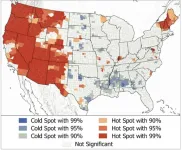(Press-News.org) The common inflammatory condition sinusitis is linked to a 40% heightened risk of a subsequent diagnosis of rheumatic disease, particularly in the 5 to 10 years preceding the start of symptoms, finds research published in the open access journal RMD Open.
The risks seem to be greatest for a blood clotting disorder (antiphospholipid syndrome) and a condition that affects the body’s production of fluids, such as spit and tears, known as Sjögren’s syndrome, the findings indicate.
Sinusitis refers to inflammation of the lining of the sinuses, the small, air-filled cavities behind the cheekbones and forehead. And previously published research points to a link between various types of lung irritants, including air pollution and respiratory infections, and the development of rheumatoid arthritis, for example.
But it’s not clear if sinusitis might also be a potential predisposing factor for other types of rheumatic disease. In a bid to plug this knowledge gap, the researchers carried out a case-control study.
They used data from the Rochester Epidemiology Project (REP), a medical records-linkage system of over 500,000 people resident in Olmsted County, Minnesota at some point between 1966 and 2014.
The study sample included 1729 adults, newly diagnosed with a systemic autoimmune rheumatic disease, such as rheumatoid arthritis, antiphospholipid syndrome, and Sjögren’s syndrome; or vasculitis (blood vessel inflammation), such as giant cell arteritis (temporal artery inflammation) and polymyalgia rheumatica (muscle pain and stiffness).
Each of these patients (average age 63; two thirds women) was matched with 3 people (5187 in total) with no rheumatic disease, based on age at diagnosis and sex.
Cases of sinusitis before the diagnosis of rheumatic disease were divided into time segments of 1 to 5 years; 5 to 10 years; and 10 or more years.
Potentially influential factors were accounted for: age, weight (BMI), and smoking status at rheumatic disease diagnosis, sex, race and ethnicity.
The average time that elapsed between an episode of sinusitis and diagnosis of rheumatic disease was just over 7.5 years, with the most common diagnosis, rheumatoid arthritis (688) and polymyalgia rheumatica (610).
A history of sinusitis was associated with a 40% heightened risk of any new diagnosis of rheumatic disease, with the association strongest for systemic autoimmune rheumatic diseases, such as antiphospholipid syndrome–7-fold increased risk—and Sjögren’s syndrome—more than double the risk.
Acute sinusitis was associated with an 18% heightened risk of seronegative rheumatoid arthritis (symptoms but no detectable antibodies).
The association between sinusitis and newly diagnosed rheumatic disease was strongest in the 5–10 years preceding symptom start, where the risk was 70% higher, overall, but 3-fold higher for Sjögren’s syndrome and twice as high for polymyalgia rheumatica.
And the more frequent the episodes of sinusitis, the greater were the chances of a new rheumatic disease diagnosis. For example, those experiencing 7 or more were nearly 5 times as likely to be diagnosed with systemic autoimmune disease, nearly 9 times as likely to be diagnosed with Sjögren’s syndrome, and twice as likely to be diagnosed with vasculitis.
Serial episodes of sinusitis without a previous history also showed a significant dose-response association with seronegative rheumatoid arthritis, rising to a quadrupling in risk for 5 or more episodes.
And overall, the association between sinusitis and rheumatic disease was strongest in people who had never smoked.
This is an observational study, and therefore no definitive conclusions can be drawn about causal factors. The researchers also acknowledge several limitations to their findings, including a predominantly White study population and few cases of certain types of rheumatic disease.
And reverse causation, whereby the rheumatic diseases themselves increase the risk of sinusitis, can’t be ruled out, they add.
But bacterial pathogens, such as those involved in sinusitis, might have a role in rheumatic disease, added to which sinusitis is associated with speeding up artery hardening, lending extra weight to its potential inflammatory effects, explain the researchers.
And they conclude: “Overall, these findings point towards a role for sinus inflammation in the presentation, and possibly pathogenesis, of rheumatic disease.”
END
Sinusitis linked to 40% heightened risk of rheumatic disease
Association strongest in 5-10 years before start of rheumatic symptoms. Risks greatest for blood clotting disorder and syndrome that affects body’s fluid production
2024-02-28
ELSE PRESS RELEASES FROM THIS DATE:
Poorly controlled asthma emits same quantity of greenhouse gas as 124,000 homes each year in the UK
2024-02-28
Patients whose asthma is poorly controlled have eight times excess greenhouse gas emissions compared with those whose condition is well controlled—equivalent to that produced by 124,000 homes each year in the UK—indicates the first study of its kind, published online in the journal Thorax.
Improving the care of asthma patients could achieve substantial carbon emissions savings, and help the NHS meet its net zero target, say the researchers.
Healthcare is a major contributor to greenhouse gas emissions and in 2020 the NHS set an ambitious target of reducing its carbon footprint by 80% over the next 15 years, with the aim of reaching net zero by 2045, ...
Whole genome sequencing reveals new genetic marker for cardiomyopathy
2024-02-28
In the first study to use whole genome sequencing to examine tandem repeat expansions in heart conditions, scientists at The Hospital for Sick Children (SickKids) have laid the groundwork for early detection of and future precision therapies for cardiomyopathy.
Cardiomyopathy is an inherited heart condition that impacts up to one in 500 individuals. The condition affects the structure and function of the heart and can ultimately lead to heart failure.
The SickKids-led study, published in eBioMedicine, part of The Lancet Discovery Science, indicates that tandem repeats – a form of genetic variation – are more often expanded ...
The West is best to spot UFOs
2024-02-28
“This [Tic Tac-shaped object that] had just traveled 60 miles in…less than a minute, was far superior in performance to my brand-new F/A-18F and did not operate with any of the known aerodynamic principles that we expect for objects that fly in our atmosphere.”
In July of 2023, retired commander in the U.S. Navy David Fravor testified to the House Oversight Committee about a mysterious, Tic Tac-shaped object that he and three others observed over the Pacific Ocean in 2004. The congressional hearings riveted ...
Therapy could be effective treatment for non-physical symptoms of menopause
2024-02-28
Interventions such as mindfulness and cognitive behavioural therapy (CBT), could be an effective treatment option for menopause-related mood symptoms, memory and concentration problems, finds a new study by UCL researchers.
The research, published in the Journal of Affective Disorders, is the most up-to-date study of its kind, providing a meta-analysis of 30 studies involving 3,501 women who were going through the menopause in 14 countries, including the UK, USA, Iran, Australia, and China.
Lead author, Professor Aimee Spector (UCL Psychology & Language Sciences), said: “Women can spend a notable number of years in their ...
Artificial intelligence has huge potential in infection control, as long as the right questions are asked and safeguards are in place
2024-02-28
*Please mention the European Congress of Clinical Microbiology and Infectious Diseases (ECCMID 2024, Barcelona, 27-30 April) if using this material*
A new research review to be given at a pre-congress day for this year’s European Congress of Clinical Microbiology and Infectious Diseases (ECCMID 2024) will look at the many ways artificial intelligence can help prevent infectious disease outbreaks including ensuring staff wear personal protective equipment correctly and managing day-to-day hospital activities ...
How artificial intelligence could improve speed and accuracy of response to infectious disease outbreaks in hospitals, and even prevent them
2024-02-28
*Please mention the European Congress of Clinical Microbiology and Infectious Diseases (ECCMID 2024, Barcelona, 27-30 April) if using this material*
A new research review to be given at a pre-congress day for this year’s European Congress of Clinical Microbiology and Infectious Diseases (ECCMID 2024) will highlight the potential artificial intelligence (AI) has to improve the speed and accuracy of investigations into infectious disease outbreaks in hospitals, and potentially provide real time information to stop or prevent them. The talk will be by Dr Jonas Marschall, Division of Infectious Diseases, Washington University School ...
Walleye struggle with changes to timing of spring thaw
2024-02-27
Walleye are one of the most sought-after species in freshwater sportfishing, a delicacy on Midwestern menus and a critically important part of the culture of many Indigenous communities. They are also struggling to survive in the warming waters of the Midwestern United States and Canada.
According to a new study published Feb. 26 in the journal Limnology and Oceanography Letters, part of the problem is that walleye are creatures of habit, and the seasons — especially winter — are changing so fast that this iconic species of freshwater fish can’t keep up.
The timing of walleye spawning ...
New UC Berkeley-led study reveals widen gap on racial inequality in higher education
2024-02-27
A UC Berkeley-led study revealed that disparities in the share of Black and Latino students admitted to America’s elite colleges and universities have endured and even widened over the last 40 years.
The study, "Shifting Tides: The Evolution of Racial Inequality in Higher Education from the 1980s through the 2010s,"(link is external) was published this month in Sage Journals and conducted by a team of researchers from UC Berkeley’s Social Sciences D-Lab, SUNY Polytechnic Institute, University of Arizona and Portland State University. It used four national survey datasets to examine college attendance trends across ...
New study links placental oxygen levels to fetal brain development
2024-02-27
A new study shows oxygenation levels in the placenta, formed during the last three months of fetal development, are an important predictor of cortical growth (development of the outermost layer of the brain or cerebral cortex) and is likely a predictor of childhood cognition and behaviour.
“Many factors can disrupt healthy brain development in utero, and this study demonstrates the placenta is a crucial mediator between maternal health and fetal brain health,” said Emma Duerden, Canada Research Chair in Neuroscience & Learning Disorders ...
Long-term survivors of childhood cancer at higher risk of death following heart issues; threshold for treating risk factors should be lower
2024-02-27
New research out of VCU Massey Comprehensive Cancer Center and VCU Health Pauley Heart Center indicates that survivors of childhood cancer are at a significantly higher risk of death following a major cardiovascular event — including heart failure, heart attack or stroke — than the general public.
The findings – published this week in the Journal of the American College of Cardiology — could fuel advocacy for a paradigm shift in clinical heart health guidelines to address cardiovascular risk factors at an earlier age in childhood cancer survivors.
“We found that the risk of death after a major cardiovascular event in a 50-year-old in the general population ...
LAST 30 PRESS RELEASES:
Securing AI systems against growing cybersecurity threats
Longest observation of an active solar region
Why nail-biting, procrastination and other self-sabotaging behaviors are rooted in survival instincts
Regional variations in mechanical properties of porcine leptomeninges
Artificial empathy in therapy and healthcare: advancements in interpersonal interaction technologies
Why some brains switch gears more efficiently than others
UVA’s Jundong Li wins ICDM’S 2025 Tao Li Award for data mining, machine learning
UVA’s low-power, high-performance computer power player Mircea Stan earns National Academy of Inventors fellowship
Not playing by the rules: USU researcher explores filamentous algae dynamics in rivers
Do our body clocks influence our risk of dementia?
Anthropologists offer new evidence of bipedalism in long-debated fossil discovery
Safer receipt paper from wood
Dosage-sensitive genes suggest no whole-genome duplications in ancestral angiosperm
First ancient human herpesvirus genomes document their deep history with humans
Why Some Bacteria Survive Antibiotics and How to Stop Them - New study reveals that bacteria can survive antibiotic treatment through two fundamentally different “shutdown modes”
UCLA study links scar healing to dangerous placenta condition
CHANGE-seq-BE finds off-target changes in the genome from base editors
The Journal of Nuclear Medicine Ahead-of-Print Tip Sheet: January 2, 2026
Delayed or absent first dose of measles, mumps, and rubella vaccination
Trends in US preterm birth rates by household income and race and ethnicity
Study identifies potential biomarker linked to progression and brain inflammation in multiple sclerosis
Many mothers in Norway do not show up for postnatal check-ups
Researchers want to find out why quick clay is so unstable
Superradiant spins show teamwork at the quantum scale
Cleveland Clinic Research links tumor bacteria to immunotherapy resistance in head and neck cancer
First Editorial of 2026: Resisting AI slop
Joint ground- and space-based observations reveal Saturn-mass rogue planet
Inheritable genetic variant offers protection against blood cancer risk and progression
Pigs settled Pacific islands alongside early human voyagers
A Coral reef’s daily pulse reshapes microbes in surrounding waters
[Press-News.org] Sinusitis linked to 40% heightened risk of rheumatic diseaseAssociation strongest in 5-10 years before start of rheumatic symptoms. Risks greatest for blood clotting disorder and syndrome that affects body’s fluid production


